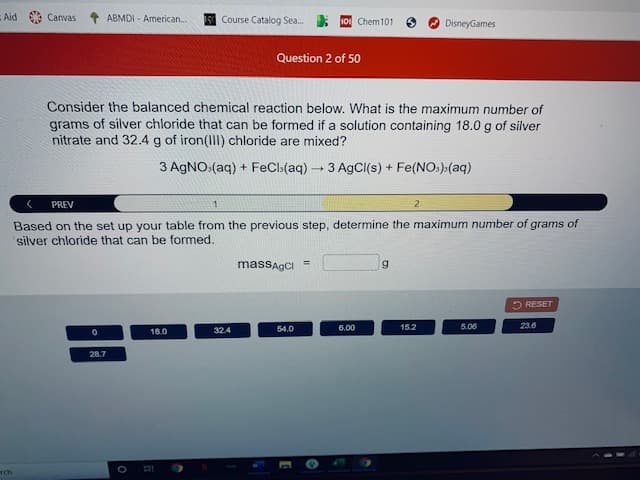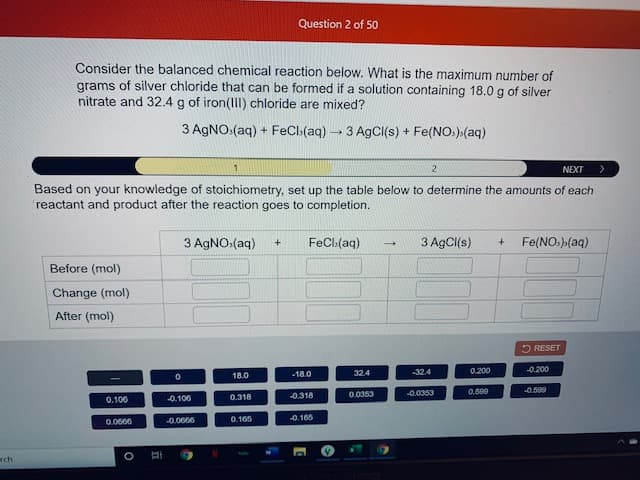Consider the balanced chemical reaction below. What is the maximum number of grams of silver chloride that can be formed if a solution containing 18.0 g of silver nitrate and 32.4 g of iron(Il) chloride are mixed? 3 AGNO:(aq) + FeCl(aq) - 3 AgCI(s) + Fe(NO.).(aq)
Consider the balanced chemical reaction below. What is the maximum number of grams of silver chloride that can be formed if a solution containing 18.0 g of silver nitrate and 32.4 g of iron(Il) chloride are mixed? 3 AGNO:(aq) + FeCl(aq) - 3 AgCI(s) + Fe(NO.).(aq)
Introduction to General, Organic and Biochemistry
11th Edition
ISBN:9781285869759
Author:Frederick A. Bettelheim, William H. Brown, Mary K. Campbell, Shawn O. Farrell, Omar Torres
Publisher:Frederick A. Bettelheim, William H. Brown, Mary K. Campbell, Shawn O. Farrell, Omar Torres
Chapter4: Chemical Reactions
Section: Chapter Questions
Problem 4.93P: 4-93 Ammonia is prepared industrially by the reaction of nitrogen and hydrogen according to the...
Related questions
Question

Transcribed Image Text:Consider the balanced chemical reaction below. What is the maximum number of
grams of silver chloride that can be formed if a solution containing 18.0 g of silver
nitrate and 32.4 g of iron(Il) chloride are mixed?
3 AGNO:(aq) + FeCl(aq) - 3 AgCI(s) + Fe(NO.).(aq)

Transcribed Image Text:Question 2 of 50
Consider the balanced chemical reaction below. What is the maximum number of
grams of silver chloride that can be formed if a solution containing 18.0 g of silver
nitrate and 32.4 g of iron(III) chloride are mixed?
3 AGNO.(aq) + FeCl.(aq) 3 AgCI(s) + Fe(NO.).(aq)
2
NEXT
Based on your knowledge of stoichiometry, set up the table below to determine the amounts of each
reactant and product after the reaction goes to completion.
3 AGNO:(aq)
FeCl.(aq)
3 AgCI(s)
Fe(NO.)»(aq)
Before (mol)
Change (mol)
After (mol)
2 RESET
32.4
-32.4
0.200
-0.200
18.0
-18.0
-0.318
0.0353
-0.0353
0.500
-0.599
0.100
-0.106
0.318
0.0666
-0.0006
0.165
-0.165
ch
Expert Solution
This question has been solved!
Explore an expertly crafted, step-by-step solution for a thorough understanding of key concepts.
This is a popular solution!
Trending now
This is a popular solution!
Step by step
Solved in 3 steps with 8 images

Knowledge Booster
Learn more about
Need a deep-dive on the concept behind this application? Look no further. Learn more about this topic, chemistry and related others by exploring similar questions and additional content below.Recommended textbooks for you

Introduction to General, Organic and Biochemistry
Chemistry
ISBN:
9781285869759
Author:
Frederick A. Bettelheim, William H. Brown, Mary K. Campbell, Shawn O. Farrell, Omar Torres
Publisher:
Cengage Learning

Chemistry for Engineering Students
Chemistry
ISBN:
9781337398909
Author:
Lawrence S. Brown, Tom Holme
Publisher:
Cengage Learning

Principles of Modern Chemistry
Chemistry
ISBN:
9781305079113
Author:
David W. Oxtoby, H. Pat Gillis, Laurie J. Butler
Publisher:
Cengage Learning

Introduction to General, Organic and Biochemistry
Chemistry
ISBN:
9781285869759
Author:
Frederick A. Bettelheim, William H. Brown, Mary K. Campbell, Shawn O. Farrell, Omar Torres
Publisher:
Cengage Learning

Chemistry for Engineering Students
Chemistry
ISBN:
9781337398909
Author:
Lawrence S. Brown, Tom Holme
Publisher:
Cengage Learning

Principles of Modern Chemistry
Chemistry
ISBN:
9781305079113
Author:
David W. Oxtoby, H. Pat Gillis, Laurie J. Butler
Publisher:
Cengage Learning

Chemistry for Engineering Students
Chemistry
ISBN:
9781285199023
Author:
Lawrence S. Brown, Tom Holme
Publisher:
Cengage Learning

Introductory Chemistry: A Foundation
Chemistry
ISBN:
9781337399425
Author:
Steven S. Zumdahl, Donald J. DeCoste
Publisher:
Cengage Learning

Chemistry: The Molecular Science
Chemistry
ISBN:
9781285199047
Author:
John W. Moore, Conrad L. Stanitski
Publisher:
Cengage Learning